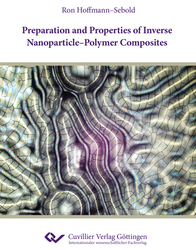| Fachbereiche | |
|---|---|
| Buchreihen (96) |
1378
|
| Nachhaltigkeit |
3
|
| Gesundheitswesen |
1
|
| Geisteswissenschaften |
2363
|
| Naturwissenschaften |
5406
|
| Mathematik | 229 |
| Informatik | 319 |
| Physik | 980 |
| Chemie | 1363 |
| Geowissenschaften | 131 |
| Humanmedizin | 243 |
| Zahn-, Mund- und Kieferheilkunde | 10 |
| Veterinärmedizin | 108 |
| Pharmazie | 147 |
| Biologie | 835 |
| Biochemie, Molekularbiologie, Gentechnologie | 121 |
| Biophysik | 25 |
| Ernährungs- und Haushaltswissenschaften | 45 |
| Land- und Agrarwissenschaften | 1004 |
| Forstwissenschaften | 201 |
| Gartenbauwissenschaft | 20 |
| Umweltforschung, Ökologie und Landespflege | 148 |
| Ingenieurwissenschaften |
1791
|
| Allgemein |
98
|
|
Leitlinien Unfallchirurgie
5. Auflage bestellen |
|
Erweiterte Suche
Preparation and Properties of Inverse Nanoparticle-Polymer Composites
Ron Hoffmann-Sebold (Autor)Vorschau
Leseprobe, PDF (1,6 MB)
Inhaltsverzeichnis, PDF (37 KB)
Die Dissertation legt die Überwindung der Nachteile von niedrig gefüllten Nanopartikel–Polymer–Kompositen durch die anfängliche Herstellung eines stabilen, perkolierenden anorganischen Nanopartikelgerüsts dar. Dessen sehr hohe Porosität wird entweder aus der Gasphase mittels Flammensprühpyrolyse (FSP) oder alternativ über nasschemische Präparation mittels Sol–Gel–Verfahren erreicht. Im Anschluss werden die perkolierenden Strukturen mittels kapillargetriebener Infiltration mit einem Monomer gefüllt, welches daraufhin photochemisch polymerisiert wird. Das erhaltene System wird inverses Nanopartikel–Polymer–Komposit genannt. Dünne Schichten daraus können beispielweise für haftvermittelnde, elektrische sowie optoelektronische Funktionsmaterialien eingesetzt werden. Die ursprüngliche Partikelnetzwerk– und Porenstruktur bleibt während der Präparation erhalten und durch die Infiltration sowie anschließende Monomer–Polymerisation konnte die elektrische Leitfähigkeit von Halbleiternanopartikeln deutlich gesteigert werden. Für den Reaktionsmechanismus innerhalb der mesoskaligen Porenstruktur wurde ein analytisches Kinetikmodell der freien radikalischen Photopolymerisation unter Einschluss entwickelt und mit diffuser Reflexions-FTIR-Spektroskopie (DRIFTS) bestätigt.
This dissertation presents how the drawbacks of low–filled nanoparticle–polymer composites can be overcome by initially preparing a stable percolating inorganic nanoparticle framework, in which very high porosity is achieved, either from the gas phase by flame spray pyrolysis (FSP) or, alternatively, via wet chemical preparation using a sol–gel process. Subsequently, the percolating structures are filled with a monomer by capillary–driven infiltration, which is then photochemically polymerized. The obtained system is called inverse nanoparticle–polymer composite. Thin–film layers from the composite can be applied, for example, as adhesion–promoting, electrical or optoelectronic functional materials. The original particle network and pore structure is preserved during the preparation, and the electrical conductivity of semiconducting nanoparticles could be significantly increased by infiltration, as well as subsequent monomer polymerization. An analytical model of the reaction kinetics was developed for free radical photopolymerization under spatial confinement within the mesoscale pore structure and confirmed by diffuse reflectance FTIR spectroscopy (DRIFTS).
| ISBN-13 (Printausgabe) | 9783736977426 |
| ISBN-13 (E-Book) | 9783736967427 |
| Buchendformat | A5 |
| Sprache | Englisch |
| Seitenanzahl | 246 |
| Umschlagkaschierung | glänzend |
| Auflage | 1. |
| Erscheinungsort | Göttingen |
| Promotionsort | Bremen |
| Erscheinungsdatum | 28.02.2023 |
| Allgemeine Einordnung | Dissertation |
| Fachbereiche |
Chemie
Physikalische Chemie |
| Schlagwörter | Füllgrad, Degree of filling, Nanopartikel, Nanoparticle, Polymermatrix, Polymer matrix, Komposit, Composite, Sol–Gel–Verfahren, Sol–gel–process, Kapillarkraft getrieben, Capillary force induced, Flüssigkeitseintritt, Liquid imbibition, Porosität, Porosity, Perkolation, Percolation, Polyacrylat, Polyacrylate, Silan–Haftvermittler–Chemie, Silane coupling agent’s chemistry, Vernetzungsgrad, Degree of Cross–linking, Nano–Einschluss, Nano–confinement, Polymerisationskinetik, Polymerization kinetics, Indium Zinn Oxid, Indium tin oxide (ITO), Pyrogene amorphe Kieselsäure, Pyrogenic amorphous silica, Diffuse Reflexions–Fourier–Transformations-Infrarotspektroskopie, Diffuse reflectance infrared Fourier transform spectroscopy (DRIFT), Photopolymerisation, Photo–polymerization, Dünnschichttechnologie, Thin film technology, Flammensprühpyrolyse, Flame spray pyrolysis (FSP), Reaktionskinetkmodell, Reaction kinetic model, Halbleiterschicht, Semiconductor layer, Funktionsmaterialien, Functional materials, Bedarfsfreigabe, Release–on–demand, Leitfähigkeit, Conductance, Opto–elektronische Aktivität, Opto–electronic activity, Nanopartikelnetzwerk, Nanoparticle network, Kokontinuierliches interpenetrierendes Netzwerk, Co–continuous interpenetrating network, Themomechanische Eigenschaften, Thermomechanical properties, Nanopartikelgerüst, Nanoparticle scaffold, Inverses Nanokomposit, Inverse nanocomposite, Freie radikalische Polymerisation, Free radical polymerization, Benetzungseigenschaften, Wettability properties, Oligomerer Binder, Oligomeric binder, Oberflächenrauhigkeit, Surface roughness, Multikomponentensystem, Multi component system, Nanopartikel–Matrix–Wechselwirkung, Nanoparticle matrix interaction, Weißlichtinterferometrie, White light interferometry, Polymerisation in Mesoporen, Polymerization in mesopores, Nanotechnologie, Nanotechnology |
| URL zu externer Homepage | https://www.ifam.fraunhofer.de/de/technologien/klebstoffe-verbundwerkstoffe.html |








